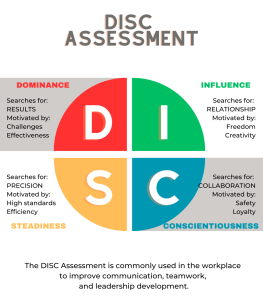All people have potential for success, but their chances are higher if they work in activities that are suitable for their profile.
Do you really know yourself? Do you believe that your public image is the same as the mirror reflects? Are you clear about what really motivates you? Do you know how you behave under pressure?
The answer to these questions is the key to the DISC Profile, one of the most widely used profile analysis tools in the world, with over 98% accuracy. The system is used to assess the predominant and secondary behavioral profile, in order to understand how the evaluated person responds to external challenges and stimuli and what are the main internal motivations that impact the individual’s actions and reactions. By being aware of these behavioral tendencies, it is possible to develop ways to overcome limitations and enhance the strengths associated with your behavioral style, as well as learn how to deal with different profiles from yours at work and perceive how one can complement the other.
You’ve probably heard of Empedocles’ Greek theory, which attributed to the four basic elements of nature — fire, water, earth, and air — the influence on people’s behavior. Or you may have tried to fit into one of the four universal temperaments proposed by Hippocrates, the father of Western medicine, who proposed the thesis that our temperament is associated with physiology, creating the concept of Choleric, Sanguine, Phlegmatic, and Melancholic. In the 20th century, Swiss doctor and psychiatrist Carl Gustav Jung used a similar system to classify individuals into four other concepts: Producer, Sensitive, Intuitive, and Analytical.
However, all previous attempts seemed not to be clear enough and applicable to the business environment until 1926 when American psychologist William Moulton Marston (creator of Wonder Woman), using statistical and biophysical knowledge, developed the DISC theory, used by the American Army, US Armed Forces, and NASA and in thousands of organizations, described in the book “Emotions of Normal People,” released in 1928.
DISC stands for Dominance, Influence, Steadiness, and Conscientiousness. According to this theory, all people have potential for success, but the chances of achieving it are greater if they work in activities that are suitable for their profile. By knowing the particularities of each one, it is fundamental to bear in mind that no profile is better or worse.
In determining behavioral style, some factors can influence it. The first is hereditary, in addition to models, examples, mentors, environments, lived experiences, and self-knowledge.
We list below the most characteristic behaviors of each profile. However, it is important to know that they manifest themselves at different levels of intensity, and each person has a unique combination of these four behavioral profiles, which, when added to values, beliefs, and other personal aspects, constitute the individual’s personality.

D – Dominant, Direct, Decisive
The D shows how much a person can solve problems and how they respond to challenges. Among the keywords of Dominance are results, challenges, effectiveness.
Strengths: They are dissatisfied individuals, focused on tasks, productive, visionary, energetic, optimistic, feel the need for change, need to correct what is uncomfortable in the environment, independent, self-sufficient, courageous, action-oriented, demand results, overcome opposition, and are protagonists. The biggest fear is that others will take advantage.
Points to develop: Like all profiles, they have limitations. Dominant people may exhibit different levels of these characteristics: insensitivity, coldness, arrogance, sarcasm, cruelty, and ruthlessness. They may be argumentative and impatient, prejudiced, have little tolerance for mistakes, don’t analyze details, get bored with trivialities, make impulsive decisions, manipulative and demanding, work is a priority, rude and tactless, the ends justify the means, impatient with low-performing people, don’t allow people to relax, proud, not intimidated by unpopularity, praise little and don’t give up when they lose.

I – Influential, Interactive, People-oriented
The I shows how much a person can influence and persuade others. It’s the communicative profile, but can struggle with making things happen. It seeks relationships, freedom, and creativity, and makes the environment an ally. It’s active, but very emotional. It’s focused on people, which can lead to disorganization. It has an optimistic and positive outlook on life. It has charisma and the ability to connect with others. Its biggest fear is rejection.
Strengths: Extroverted, warm, friendly, talkative, life of the party, compassionate and demonstrative, generous and sincere, good sense of humor, memory for stories and jokes, enthusiastic and expressive, good on stage, lives in the present, turns disaster into humor, makes friends easily, thrives on compliments, enjoys spontaneous activities, volunteers for work, thinks of new activities, makes a good impression, has energy and enthusiasm, inspires others to join in and work together.
Areas for improvement: Undisciplined, restless, and naive, disorganized, unproductive, unreliable, egocentric, excessive and compulsive talker, fearful and insecure, lives in trivialities, controlled by circumstances, selfish and hateful, easily angered, can seem fake, disorganized, doesn’t listen to the whole story, needs to be the center of attention, dominates conversations, speaks for others, inconsistent, forgets obligations, prefers to talk instead of work, undisciplined, doesn’t establish priorities, decides based on feelings, wastes time talking.

S – Stable, Secure, Sensitive
The S shows the pace at which a person carries out activities and responsibilities. They seek collaboration, security, loyalty, work well in teams, are highly reliable, but can be possessive and resistant to change. Their greatest fear is to lose security.
Strengths: Sympathetic and diplomatic, efficient and organized, reliable, conservative and practical, determined leader, moderate personality, relaxed and laid-back, patient and well-balanced, quiet but witty, supportive and kind, keeps emotions hidden, happy in harmony with life, unhurried, can take the good with the bad, not easily upset, pleasant and fun, good listener, intelligent sense of humor, has several close friends, competent and consistent, peaceful and agreeable, has administrative ability, mediates problems, avoids conflicts, good under pressure, finds the easy way.
Areas for improvement: Unmotivated and indifferent, a bystander, selfish and stubborn, stingy, self-protective, indecisive and fearful, unenthusiastic, reticent, avoids responsibilities, quiet, gives in too much, undisciplined and unchanging, does not organize the home, takes life too casually, dampens enthusiasm, indifferent to plans, judgmental, sarcastic and provocative, not goal-oriented, lacks self-motivation, hard to get moving, resents being pushed, lethargic and careless, discourages others, observer.

C — Correct, Controlled, Complacent
The C shows how the person responds to rules and regulations established by others. It seeks precision, high efficiency standards, is cautious, perfectionist, not very daring, sensitive, detail-oriented. Its biggest fear is criticism.
Strengths: self-sacrifice, serious, talented and creative, artistic and musical gifts, philosophical and poetic, lover of beauty, sets high standards, wants everything done correctly, sacrifices its own will, makes friends cautiously, content to stay in the background, avoids calling attention to itself, follows the plan, detail-oriented, persistent and meticulous, orderly and organized, economical, sees the problem, finds creative solutions, needs to finish what it starts, loyal, self-disciplined, process-oriented.
Areas to improve: gets depressed with imperfections, chooses the harder path, hesitant to start projects, spends too much time planning, prefers analysis over work, self-deprecating, difficult to please, sets unrealistic goals, has a deep need for approval, temperamental and negative, critical, rigid and realistic, self-centered and sensitive, vengeful, prone to persecution, unsociable, theoretical and impractical, has false humility, selective listening, introspective and low self-esteem, tendency towards hypochondria, sets unrealistic goals, feels unjustly treated and becomes upset, lives through others, socially insecure, critical and merciless, inhibits affection, argumentative and vengeful.
This TED x Talks video helps to identify each of these behavioral tendencies more clearly.
Four personality styles: Jennifer & Linda Nacif at TEDxLaJolla






